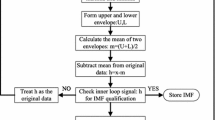Abstract
Empirical mode decomposition (EMD) approach has been believed to be potentially useful for processing the nonlinear and non-stationary LIDAR signals. To shed further light on its performance, we proposed the EMD selecting thresholding method based on multiple iteration, which essentially acts as a development of EMD interval thresholding (EMD-IT), and randomly alters the samples of noisy parts of all the corrupted intrinsic mode functions to generate a better effect of iteration. Simulations on both synthetic signals and LIDAR signals from real world support this method.




Similar content being viewed by others
References
Liu, J., Zhu, X., Zhou, J., Zang H.: Quantum Electronics Conference & Lasers and Electro-Optics. 843, (2011)
Xiong, X., Li, M., Jiang, L., Feng, S.: A method for determining cirrus height with multiple scattering. Chin. Opt. Lett. 11(10), 101101 (2013)
Donoho, D.L., Johostone, I.M.: Biometrika. 81(3):425 (1994)
Yin, S., Wang, W., Wang, W.: Novel algorithm for simultaneously detecting multiple vapor materials with multiple-wavelength differential absorption lidar. Chin. Opt. Lett. 4(12), 694 (2006)
Zhang, Y., Ma, X., Hua, D., Cui, Y.: An EMD-based denoising method for Lidar Signal. Image and Signal Processing, 2010 3rd International Congress on. 4016 (2010)
Li, D., Xu, L., Li, X., Ma, L.: Geoscience and remote sensing symposium. 2013 IEEE International 3399 (2013)
Chan, J.C., Ma, H., Saha, T.K.: Self-adaptive partial discharge signal de-noising based on ensemble empirical mode decomposition and automatic morphological thresholding. IEEE Trans. Dielectr. Electr. Insul. 21(1), 294 (2014)
Huang, N.E.: The empirical mode decomposition and the Hilbert spectrum for nonlinear and non-stationary time series analysis. Proceedings of the Royal Society of London. (1998)
Huang, N.E.: Phys. Oceanogr. 30(8):405 (2000)
Boudraa, A.O., Cexus J. C.:Denoising via empirical mode decomposition. In Proceedings of ISCCSP (2006)
Mao, Y., Que, P.: Noise suppression and flaw detection of ultrasonic signals via empirical mode decomposition. Rus. J. Nondestruct. Test 43, 196 (2007)
Jing, T., Qing Z., Yan T., Bin L., Xiao Z.: In Proceedings of 1st International Conference. Bioinformatics and Biomedical Engineering (ICBBE 2007)
Xiong, X., Li, M., Jiang, L., Feng, S.: Infrared Laser Engi. 42(6):1628 (2013)
Kabir, M.A., Shahnaz, C.: An ECG signal denoising method based on enhancement algorithms in EMD and wavelet domains. IEEE Region 10 Conference (2011)
Chatlani, N., Soraghan, J.: MD-based filtering (EMDF) of low-frequency noise for speech enhancement. IEEE Trans. Audio. Speech 20(4), 1158 (2012)
Kopsinis, Y., Kopsinis, Y., McLaughlin, S.: Development of EMD-based denoising methods inspired by wavelet thresholding. IEEE Trans. Signal process 57(4), 1351 (2009)
Acknowledgments
This work was supported by the National Natural Science Foundation of China(U1433202).
Author information
Authors and Affiliations
Corresponding author
Rights and permissions
About this article
Cite this article
Li, M., Jiang, Lh. & Xiong, Xl. A novel EMD selecting thresholding method based on multiple iteration for denoising LIDAR signal. Opt Rev 22, 477–482 (2015). https://doi.org/10.1007/s10043-015-0086-5
Received:
Accepted:
Published:
Issue Date:
DOI: https://doi.org/10.1007/s10043-015-0086-5




